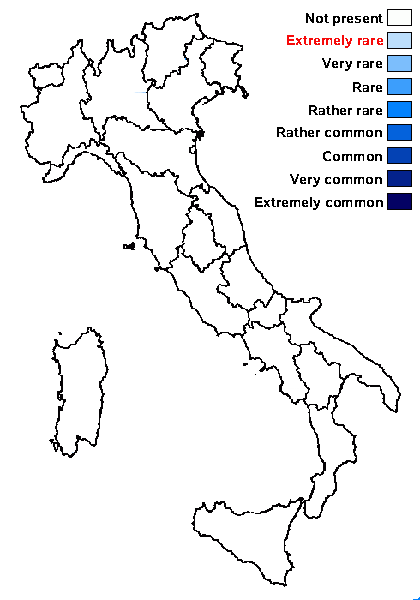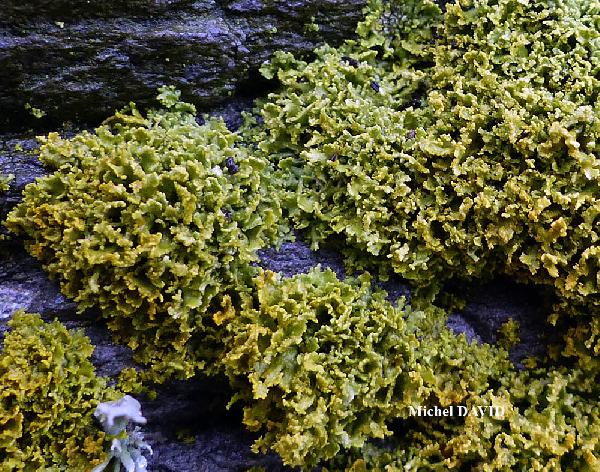Polycauliona ucrainica (S.Y. Kondr.) Frödén, Arup & Søchting
in Arup & al., Nordic J. Bot., 31, 1: 53, 2013. Basionym: Xanthoria ucrainica S.Y. Kondr. - Lichenologist, 29, 5: 435, 1997
Synonyms:
Distribution:
Description: Thallus foliose to subsquamulose, greenish yellow to lemon-yellow, sometimes grey in older parts, consisting of small 0.7-1.2(-1.7) mm long and 0.7-1.2 mm wide, basally constricted (0.2-0.3 mm wide), often slightly fan-shaped, dorsiventral, ascending, subumbilicate squamules/lobes forming small patches which often merge covering larger areas. Margins of lobes undulate, with abundant, (35-)40-60(-65) µm wide, brownish orange blastidia which also occur on the erhizinate lower surface; conblastidia absent. Upper and lower cortex paraplectenchymatous; medulla white. Apothecia unknown. Pycnidia frequent, immersed in orange-red warts. Conidia broadly ellipsoid, 2-2.5(-3) x 1-1.5(-2) µm. Photobiont chlorococcoid. Spot tests: thallus, apothecia and blastidia K+ purple-red, C-, KC-, P-, UV+ orange. Chemistry: parietin (major), fallacinal, emodin, teloschistin and parietinic acid, corresponding chemosyndrome A of Søchting (1997).Note: a species described from the Ukraine, very similar to and difficult to distinguish from P. candelaria, known from several European countries. To be looked for in Italy.
Growth form: Foliose
Substrata: bark
Photobiont: green algae other than Trentepohlia
Reproductive strategy: mainly asexual, by soredia, or soredia-like structures (e.g. blastidia)

Predictive model

Michel David - Source: http://www.lichensmaritimes.org/index.php?task=fiche&lichen=767&lang=en
France, Hanvec
as Xanthoria candelaria, identification (by P.L. Nimis) uncertain

Modified from: https://gzu.jacq.org/GZU000284907
GZU000284907 - Ident. history orig.: Xanthoria ucrainica
Collector Kondratyuk,S. Y. s.n.
Date 1994-04-26
Location Ukraine
Label Ukraine, Chernihiv town, central park
Habitat at the basis of trees, on the bark of Quercus robur
Habitus
Annotations Lichen Herbarium
M. H. Kholodny Institute of Botany (KW)
Growth form: Foliose
Substrata: bark
Photobiont: green algae other than Trentepohlia
Reproductive strategy: mainly asexual, by soredia, or soredia-like structures (e.g. blastidia)

Predictive model

Michel David - Source: http://www.lichensmaritimes.org/index.php?task=fiche&lichen=767&lang=en
France, Hanvec
as Xanthoria candelaria, identification (by P.L. Nimis) uncertain

 INDEX FUNGORUM
INDEX FUNGORUM
 GBIF
GBIF

